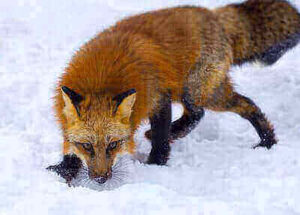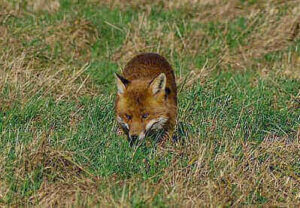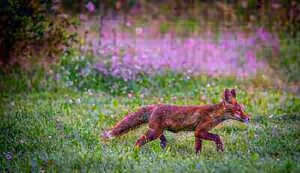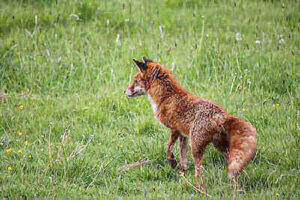Disclosure: We may earn commissions if you purchase products after clicking on a link from our site.
Do you want to hunt foxes? Would you like to learn how to hunt foxes at night? Foxes have a very good sense of smell, great vision, and a good sense of hearing. All these attributes make foxes difficult to hunt. They are clever, agile, and move very fast. In this article, we will discuss how to hunt fox as well as how to hunt them at night.

Table of Contents
How To Hunt Fox During The Day
1. Scouting
Scouting the area you want to hunt is always a good hunting practice before you go out there to hunt. You want to get an understanding of the landscape. Study the area, the vegetation there, the water sources, valleys, hills, dense foliage, dens, tall grass areas, and burrows.
Additionally, keep your eyes open for fox tracks. They are similar to dog tracks but have deeper toe indentations and reduced size. You can also use Google Earth to get a good view of the entire area and study the landscape.
2. Predator Calls
One way to hunt foxes is to use predator calls. Several predator calls will get the attention of foxes and lure them in your direction for the shot. Bird cries, rabbit in distress calls, and hare screams have been predator calls that have been successful when hunting foxes. Electronic calls as well as manual calls work. When calling, you don’t want to frighten the foxes you want to hunt. Start calling gently and gradually increase the volume of the sound. You can read a review of the best predator calls from this link.
3. Wind Direction
The wind direction plays a crucial role when hunting foxes, as these animals possess an acute sense of smell. Fox hunters must always consider the wind’s direction to avoid alerting foxes to their presence. Ideally, hunters should position themselves downwind of areas where foxes are likely to travel or den, allowing their scent to be carried away from the fox’s location.
This strategic placement minimizes the chances of foxes detecting human scent and becoming wary or fleeing the area. By paying close attention to wind direction and using it to their advantage, hunters can increase their chances of a successful fox hunt.

4. Decoy
You can also use a decoy to hunt foxes. A moving decoy, like a hare decoy, that shakes and spins becomes an irresistible prey for foxes. With a decoy like a moving hare, you have the opportunity to move or shift your position without getting noticed by the fox as its attention is fixed on the moving hare decoy. Set up the moving hare decoy about 20-40 yards away in the direction of the wind. A hare decoy works well to lure a fox into a shooting range.
5. Chicken, Turkey, or Pig Farms
Look for chicken, turkey, or pig farms not far away from where you hunt foxes. These farms will always be targets for foxes and they are usually a problem for the farmers. Talk to the farmers and get their permission to hunt foxes on their farms. Most of the time they will welcome you with open arms. Additionally, you just might also take down coyotes as well.
6. Take A Compass
Always take a compass and a map with you when you go hunting foxes. Foxes move very quickly and cover a lot of ground and to keep up you will also cover a lot of territories. You need to have a compass to know where you are and how to get out. You don’t want to lose your bearings.
7. Camouflaged Clothing
Camouflaged clothing is essential for hunters pursuing foxes, as these cunning predators have keen senses that can detect even subtle movements. Choosing appropriate camouflage patterns that blend with the surrounding environment helps hunters remain concealed from the sharp eyesight of foxes.
Earthy tones and patterns that mimic natural foliage are particularly effective in woodland or grassland habitats. Additionally, investing in camouflaged accessories like hats, gloves, and face masks further aids in minimizing the hunter’s visibility. By blending seamlessly into their surroundings, hunters increase their chances of getting within range of foxes without alerting them, thereby improving their hunting success.

8. Hunting With A Dog
Hunting foxes with domestic dogs is a traditional and effective method that relies on the keen sense of smell and agility of specially trained canines. Typically, foxhounds or terriers are used for this purpose, with each breed offering unique advantages.
Foxhounds are renowned for their endurance and ability to track scents over long distances, making them ideal for trailing foxes through varied terrain. On the other hand, terriers excel in locating and flushing foxes from their underground dens or thick vegetation.
Working in tandem with their human counterparts, these dogs help drive foxes into the open, allowing hunters to aim more effectively. The partnership between hunters and their skilled canine companions enhances the thrill of the chase and increases the likelihood of a successful hunt.
9. Spot & Stalk
The spot and stalk hunting method is the most used method to hunt foxes. Just as you use it to hunt other animals, you also apply it the same way. You position yourself to watch over an area and when you spot a fox, you carefully and slowly stalk it until you can get in a good shooting range to take a shot.
While stalking, you want to remain undetected and always be downwind of the fox as they have a very good sense of smell. Foxes also have very good eyesight and a sense of hearing. Therefore you want to avoid loosening rocks to cause noise.

How To Hunt Fox At Night
Foxes are most active and hunt for prey at night. Night hunting of foxes is similar to hunting for foxes during the except for the major issue of visibility. Foxes see very well at night and will easily pick you out. Therefore, you must be more careful at night.
1. Predator Calls
As you use predator calls when hunting foxes during the day, you can also use predator calls during the night. With hunting foxes at night, you will need a red or green light. The green or red lights will mask your position from the foxes and allow you to see them for a good shot.
2. Bait
Bait can be used to lure foxes during the night. However, foxes are very wary of bait piles and will circle a bait pile for quite some time to pick up any sign of danger. If they pick up any human or other scent they think means danger, they will not touch the bait. Foxes prey on small animals, small rodents cottontail rabbits, and small mammals.

3. Night Vision Optics
You can use night vision optics to resolve the issue of visibility when you hunt foxes at night. Thermal scopes, night vision binoculars, or monoculars can be used to help you see clearly at night. We reviewed the best night vision binoculars and the best night vision monoculars and you can read these reviews through these links.
4. Scout the Land
Scout the land during the day to become familiar with the landscape. Learn of the burrows, dens, thick vegetation, areas of tall grass, thick foliage, and other areas that foxes may use as cover. By getting familiar with the topography during the day, it will be easier to navigate it during the night. Look out for any landmarks like big trees, high hills, valleys, etc to use as markers to learn how to move through the land during the night.
5. Nearby Farms
Search for farms that are close to the areas you hunt. These farms could be hunting grounds for foxes and you might get the permission of the farmers to hunt the foxes that target their chickens, turkeys, and other animals on their farms.

6. Hunting Buddy
Hunting foxes with a hunting partner offers several advantages that can significantly improve the success of the hunt. Having a partner provides an extra set of eyes and ears, enhancing the ability to spot foxes and track their movements. It allows for strategic positioning to cover more ground effectively, increasing the chances of flushing out foxes from their hiding spots.
Additionally, hunting with a partner enables better coordination when employing hunting tactics such as calling or using decoys to lure foxes into range. Moreover, having someone else present enhances safety by providing assistance in case of emergencies or unforeseen situations during the hunt. Overall, hunting foxes with a partner enhances the hunting experience and improves the likelihood of a successful outcome.
7. Wind Direction
The wind direction plays a crucial role when hunting foxes, as these animals possess an acute sense of smell. Hunters must always consider the wind’s direction to avoid alerting foxes to their presence. Ideally, hunters should position themselves downwind of areas where foxes are likely to travel or den, allowing their scent to be carried away from the fox’s location.
This strategic placement minimizes the chances of foxes detecting human scent and becoming wary or fleeing the area. By paying close attention to wind direction and using it to their advantage, hunters can increase their chances of a successful fox hunt.

Fox Hunting Tips
1. Hunt foxes in late January or early February when they are mating. The females dig new dens that you can easily spot with the males lying on top of the dens while the females are inside. The females don’t allow the males into the den leaving them visible on the snow as a good target from a long distance.
2. Foxes hang out and hunt around forest areas using dense vegetation as cover.
3. Foxes use thick foresting and narrow passages as escape routes.
4. Foxs have a very good sense of smell, hearing, and good eyesight that they use to hunt for food and use to evade predators and danger.
5. Foxes are most active at night. They hunt for food at dusk and sleep during the day.

6. Wear camouflaged clothing that has a similar pattern to the area you are hunting in.
7. Travel as lightly as possible when hunting a fox as you will cover a lot of ground.
8. Have a map and a compass as you go hunting foxes. You don’t want to get lost and become the prey.
9. As you move through the areas searching for foxes, keep on the lookout for dense foliage, tall grass, thick vegetation, burrows, and dens.

10. Be on the lookout for fox tracks on the ground. They are similar to dog tracks but with deeper toe indentations.
11. A fox mating call is one of the most efficient ways to lure a fox out. Make the call and then move back some good distance because a fox will hear the call and come check it out.
12. Foxes are fast and agile. With their low profile, they can dart off, change direction, and evade pursuers in a second. When it sees you, it will run, change directions, and seek cover, making it difficult to see it, aim at it, and take it down.
13. Do not chase after a fox. Let it run off and you continue hunting and stalking. It will tire and go to one of its hiding spots. This will give you time to catch up and catch it when it is most vulnerable when it is eating.

The Bottom Line
Whether hunting foxes during the day or night, it is very challenging as they are very clever and dangerous. One of the major disadvantages of hunting foxes at night is the issue of visibility. To resolve that issue, you can use night vision scopes.
Foxes prey on small animals, rodents, and other animals. Hand calls have proven to be effective in luring foxes to bait although they are very wary and take their time to investigate. Opportunistic hunters often target agricultural lands when fox hunting, For good results, some fox hunters will hunt early morning in open country.
Foxes are most active at night and that makes it easier to target them if you are prepared for the night hunt. In this article, we discussed how to hunt fox at night. You can also read how to hunt gray foxes, how to hunt hogs, and how to hunt wild sheep.
